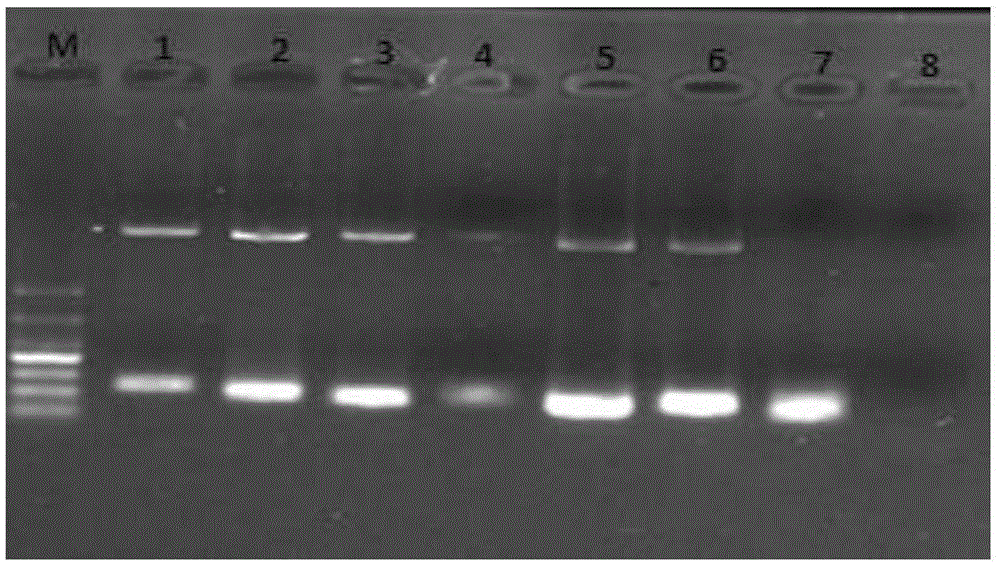Multi-fluorescence immunity analysis method for quickly distinguishing PEDV, TGEV and PoRV
A multiple fluorescence and immunoassay technology, applied in biochemical equipment and methods, DNA/RNA fragments, recombinant DNA technology, etc., can solve difficult problems and achieve lower detection costs, less sample consumption, and strong specificity Effect
- Summary
- Abstract
- Description
- Claims
- Application Information
AI Technical Summary
Problems solved by technology
Method used
Image
Examples
Embodiment 1
[0095] Embodiment 1: Construction of porcine epidemic diarrhea virus, porcine transmissible gastroenteritis virus, porcine group A rotavirus plasmid
[0096] Use the kit MiniBESTViralRNA / DNAExtractionKitVer.4.0 to extract the RNA of PEDV, TGEV, and PoRV viruses, reverse transcribe into cDNA, and perform PCR amplification with the corresponding primers above. The amplification system is as follows:
[0097]
[0098] The reaction procedure for amplification is:
[0099] Pre-denaturation at 94°C for 5 minutes;
[0100] Denaturation at 94°C for 30s, annealing at 60°C for 30s, extension at 72°C for 30s; cycle 35 times;
[0101] Final extension at 72°C for 10 min.
[0102] The amplified products were detected by agarose gel electrophoresis and purified by gel cutting.
[0103] The purified cDNA was ligated into the pMD-19T vector with a kit from TaKaRa Company. The vector ligation reaction system was as follows (10 μl):
[0104]
[0105] Reaction conditions: 16°C, over 4...
Embodiment 2
[0107] Embodiment 2: Establishment of multiple fluorescent immunoassay methods for porcine epidemic diarrhea, porcine transmissible gastroenteritis, and porcine group A rotavirus:
[0108] 1. Plasmid PCR amplification
[0109] Single-fold, double-fold and triple-fold PCR amplification was performed with specific amplification primers for porcine epidemic diarrhea, porcine transmissible gastroenteritis and porcine group A rotavirus.
[0110] Preparation of upstream primer mixture: mix P1, T1 and R1 at a ratio of 1:1:1; preparation of downstream primer mixture: mix P2, T2 and R2 at a ratio of 1:1:1. The specific regions of the above three viruses are amplified by using three specific templates, double templates, and triple templates. The preparation of double templates: mix two or two plasmids at a ratio of 1:1, and the preparation of triple templates: mix three plasmids at a ratio of 1:1:1.
[0111] The PCR amplification reaction system is as follows:
[0112]
[0113...
Embodiment 3
[0128] Embodiment 3: Multiple fluorescence immunoassay detection sensitivity experiment of PEDV, TGEV, PoRV
[0129] The prepared plasmid was quantified, diluted to 0.01 fg / ul by 10-fold dilution method, and detected by the multiple fluorescence immunoassay method established above. The sensitivity test results of multiple fluorescence immunoassays for PEDV, TGEV, and PoRV are as follows: image 3 As shown, the experimental results show that the sensitivity of PEDV, TGEV, and PoRV is high, and the detection limit is 1fg / PCR.
PUM
 Login to View More
Login to View More Abstract
Description
Claims
Application Information
 Login to View More
Login to View More - R&D
- Intellectual Property
- Life Sciences
- Materials
- Tech Scout
- Unparalleled Data Quality
- Higher Quality Content
- 60% Fewer Hallucinations
Browse by: Latest US Patents, China's latest patents, Technical Efficacy Thesaurus, Application Domain, Technology Topic, Popular Technical Reports.
© 2025 PatSnap. All rights reserved.Legal|Privacy policy|Modern Slavery Act Transparency Statement|Sitemap|About US| Contact US: help@patsnap.com



